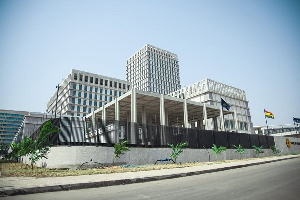NHIA Position On OXFAM/ISODEC Report On Free Universal Health Care In Ghana
DELIVERED BY SYLVESTER A. MENSAH, CHIEF EXECUTIVE OF THE NATIONAL HEALTH INSURANCE AUTHORITY
THURSDAY 17/03/11
Introduction
On Wednesday 9th March 2011, a group of four NGO’s led by Oxfam of the UK and its three Ghanaian counterparts ISODEC, Essential Services Platform of Ghana and Alliance for Reproductive Rights launched a research document titled “Achieving a Shared Goal: Free Universal Healthcare in Ghana” in which they made unsubstantiated and grossly inaccurate statements about Ghana’s home-grown National Health Insurance Scheme.
Coming from an organisation that is known for its blatant aversion to insurance, as a means of financing healthcare, the report should ordinarily not have merited any response from the NHIA. However, considering that the document is replete with factual inaccuracies, hearsay and innuendoes, whose motives are hard to fathom, save maybe intended to denigrate Ghana’s NHIS an indigenous African initiative, there is a need to set the records straight. It is also curious that some of the Ghanaian co-authors of the report were deeply involved in the set up of the very NHIS whose very structure and underlying philosophies they sought to denigrate in the report.
Push for Free Universal Health Coverage
The push by OXFAM for Ghana to implement a free health care policy for all Ghanaians must be analyzed within the context of the history of health care financing in Ghana.
Health care financing in Ghana started with a universal tax-funded system immediately after independence that could not be sustained over the years. In response to this non-sustainability, government in 1985 introduced user fees at public health facilities, but this resulted in a fall in utilization of healthcare services. An exemption policy introduced in 1987 to remedy this situation did not achieve its intended purpose of providing a safety net for the vulnerable who could not afford to pay for healthcare services.
It is this state of affairs that prompted some communities in Ghana to find alternative ways of meeting their health care financing needs, key among which was the establishment of Community Based Health Insurance Schemes (CBHIS). In 1992, the first CBHIS was launched and thereafter, several similar schemes sprung up. However, these schemes were fragmented and were not coordinated in such a way as to achieve the principles of social insurance which guided their set up, nor were they supported with tax-funds to enable them cater for the poor and the needy.
It is against this background that in 2003, the NHIS was introduced to provide financial risk protection for all persons living in Ghana so that they will be saved from incurring catastrophic health expenditures.
Following from the above, it can be said that it is only the historically handicapped, in the context of Ghana’s health financing history, who will call on Ghana at this time to revert to free health care coverage without any risk sharing on the part of users of health care services.
It is also worth noting that the provider purchaser split in healthcare financing that Ghana has introduced through the establishment of the NHIS is in line with health sector reforms sweeping across the world. Such a split brings in its wake efficiency, transparency, quality assurance as well as accountability in health service provision.
Research Methodology
In the first place, the methodology used to arrive at the conclusions of the report is seriously flawed. This comes as no surprise as this is Oxfam’s stock in trade. The report did not describe the type of study that was undertaken neither did it state the sample size of the study subjects. It is a well known fact that for a research paper of such nature to have any credibility, it must indicate clearly the type of study it set out to undertake and describe clearly the methodological approach to the study, indicating the sample size, and the sampling method used among others. The research proposal must also have gone through ethical clearance. It is however interesting to note that the report was silent on the essential ingredients of research.
To cut corners the researchers used figures that they indicated they had failed to confirm with NHIA to undertake strange mathematical calculations to arrive at their conclusions. The absence of acceptable research procedures in arriving at its conclusions makes it difficult for one to accord credibility to the study. The conclusions arrived at are therefore unacceptable and could best be described as fallacious and ludicrous, indeed an apology of a research.
Membership Data
On membership, the report states “that the official figures used by NHIA are exaggerated, highly inaccurate and misleading” on account of use of 2004 population projection figures and accumulation of membership registration. The report then attempts to provide a “more accurate estimate of the true coverage of the NHIS over time” and concludes that per their calculation, NHIA sic coverage could be as low as 18% as at 31st December 2009.
The report used a flawed mathematical formula to arrive at membership data for the NHIS when there was a primary source of information at the NHIA on membership of the NHIS and health service utilsation by members of the NHIS.
Indeed, until 2008, the denominator for calculating the percentage of registered members was the 2004 population projection but this was always made clear when the figures for registration were presented. Accordingly, this is not at all a new discovery or revelation by Oxfam.
It is important to note that membership of a scheme such as the NHIS is not based on mathematical extrapolations but collation of names, addresses and critical bio-data of people which can be verified, and the fact that the researches did not exhaust the possibility of accessing such information, suggests a calculated effort to tarnish a home grown African initiative and underscores the poor quality of the research.
For the avoidance of doubt, the NHIA presents below a table which provides an overview of membership of the NHIS from 2006 to 2009.
Year Estimated population of Ghana Total registered members Total Active members Registered members as a % of population Active members as % population
2006 21,876,031 3,867,862 2,422,097 18 11
2007 22,387,911 8,184,294 6,674,270 37 30
2008 22,876,031 12,518,560 9,969,846 55 44
2009 23,416,518 14,511,777 11,132,981 62 48
Source for Population Data: Ghana Statistical Service
In order to determine what they referred to as a “more accurate” active membership, OXFAM used NHIA reported premiums and settled on GH¢13 as the average premium paid by informal sector members of the scheme. OXFAM then used these numbers to calculate the number of informal sector members and extrapolated this result to fit the wider population. Against the background that Oxfam doubted the credibility of NHIA statistics it is curious that reported premiums by NHIA formed a reliable basis for their calculations. It is also curious that OXFAM made generalizations on NHIS membership renewal rates based on interaction with only 1 out of 145 schemes (Box 3 page 25).
OXFAM also misquoted or misrepresented other reports they purportedly relied on for their study. A clear example is the Citizens’ Assessment Report of 2008 authored by the National Development Planning Commission (NDPC). Whereas the NDPC report indicated that from a study it had conducted 47.9% of the population had valid NHIS ID cards, the Oxfam report misstated this figure as 45% (Page 24 of the report).
To buttress the credibility of NHIA data on NHIS membership compared to Oxfam’s, it is instructive to note that apart from the NDPC’s Citizens Assessment Report, the Ghana Demographic & Health Survey of 2008 found that about 39% of women and 29% of men aged 15-49 were members of the NHIS, with 9 out of 10 insured respondents having valid NHIS ID cards. Also, the 2008 annual report of the Ghana Health Service indicated that 59% of admissions in Ghana Health Service facilities in 2008 were on account of NHIS membership. Testimony to the pervasiveness of the NHIS in Ghana is manifested in the 2009 Ghana Health Service Annual Report which states that 81% of internally generated funds (user fees) of the service is from NHIS card bearing members.
Coverage of the Poor
As with most healthcare systems around the world, coverage of the poor has been a perennial concern and Ghana’s is no exception. That said Ghana’s NHIS has been structured to provide coverage for a significant population of the poor and vulnerable. This includes children under the age of 18, the elderly, pensioners of the Social Security Scheme, pregnant women and indigent. These groups together constitute about 70% of the total registered membership of the NHIS.
Realizing the need for further improving coverage of the poor, the NHIS through collaboration with the Ministry of Employment & Social Welfare under the Livelihood Empowerment Against Poverty Project (LEAP) and other initiatives such as faith based projects is expanding coverage of the poor within the informal sector. The NHIA is further seeking a redefinition of poor and vulnerable in the context of an ongoing legal reform of the NHIS to ensure their effective coverage.
NHIS Fund Unaccounted for in 2008
The allegation in the report that 45% NHIS Funds could not be accounted for in 2008 is as laughable as it is ludicrous. Oxfam needs to know that the National Health Insurance Fund (NHIF) is a public fund that is subject to public audit. The fund is accordingly audited on an annual basis by the Auditor-General through its appointed external auditors and the auditors have made no audit finding to substantiate Oxfam’s baseless accusation. The allegation therefore seeks not only to denigrate the NHIS, but also an important institution such as the Auditor General of the Republic Ghana, an independent sovereign state.
The NHIA hereby reassures the general public that the National Health Insurance Fund (NHIF) is being prudently managed.
Lack of Transparency and Mismanagement
The financial management of the NHIS and its operations are subject to the highest forms of scrutiny. Indeed the budget and allocation formula of the NHIS are subject to the rigours of ministerial and parliamentary approval. Also the audited accounts of the NHIA are subjected to parliamentary oversight as required by law.
In addition to the foregoing, NHIA voluntarily disseminates information about the NHIS through stakeholder engagements, hosting of annual and other reports on the NHIS website, which Oxfam has had the benefit of accessing and using albeit with its own twist, and public education. Indeed it is interesting that the authors of the report make copious reference to data from NHIA annual reports and website yet cite lack of transparency on the part of the NHIA.
Conflict with the Ministry of Health and Stakeholders
As an agency of the Ministry of Health, the NHIA is subject to the Authority of the ministry. As such the NHIA continually seeks the guidance of the ministry on key policy matters relating to the NHIS. The NHIA also seeks the approval of the Ministry on major initiatives such as development of medicines lists and service tariffs, development of payment mechanisms, enforcement of prescribing levels and standard treatment guidelines and review of other strategic processes within the NHIS.
As regards the various stakeholders of the NHIS, the NHIA regularly engages with them through forums, meetings, technical committees, to name a few, which allow for exchange of views on various issues pertaining to the implementation of the NHIS. Recent examples are the annual NHIA’s participation in meetings of the Ghana Medical Association, the Ghana Health Service Medical Superintendents Group, the Community Pharmacists Practitioners Association and the Society of Private Medical and Dental Practitioners. The NHIA is also an active member of the Inter-Agency Steering Committee of the Ministry of Health.
Against this background it is justifiable to say that the allegation of a perpetual conflict is a ploy by Oxfam and others to drive a wedge between the NHIA and its stakeholders for purposes that only they can explain, and the NHIA hereby serves notice to Oxfam that its parochial agenda cannot succeed in an era that ‘divide and rule’ has been banished into the annals of history never to be resurrected again in an independent nation such as Ghana.
NHIS Tariff Differentials between Provider Types
There are, indeed, some differences in tariffs paid to providers depending on type of ownership. This is because in developing the tariffs administrative cost of the providers are taken into consideration. Whereas personnel emoluments and other administrative cost borne by GHS providers are paid by government and personnel emoluments of mission hospitals are taken up by government, those of private providers are borne by the providers themselves. Therefore, it is not illogical to pay private providers higher tariffs to compensate for their administrative cost. The payment of private providers slightly more than public providers is therefore justifiable and allusions in Table 5 of the report to savings of GHC 54million on account of tariff equalisation are untenable.
DRG tariff –creep and up-coding are well-known phenomena in health insurance globally. The NHIA has identified these challenges and is applying all measures including review of the DRG, clinical audit and introduction of an additional payment mechanism (capitation for primary health care services) to address the issues.
MEDICINES PRICING
The NHIA is aware that the Ministry of Health is actively dealing with issues relating to the supply chain of medicines within the public sector of Ghana. That notwithstanding Oxfam’s claim that as much GHC65 million could be saved on medicines sounds incredible.
RECOGNITION & ACCLAIM ON THE GLOBAL STAGE
The National Health Insurance Scheme (NHIS), like all other programmes of similar nature has its challenges. That notwithstanding, the Scheme is gaining international acclaim as a potential model of healthcare financing in the developing world. In November 2010, the NHIS was selected by the United Nations Development Programme (UNDP) and the World Health Organization (WHO) for an award at its 2010 Global South-South Development Exposition held in Geneva, Switzerland for showing leadership in health insurance implementation in the developing world. The citation acknowledged the management of the National Health Insurance Scheme (NHIS) for implementing a scheme with the following attributes:
1. Demand-driven policy which is aligned to development priorities of the nation and fitting into broad development agenda (GPRS).
2. Country-owned and not a donor, agency or outsider-led initiative.
3. A policy derived from active and effective in-country leadership over country strategic development priorities.
4. A policy that was conceived and developed through a broad-based partnership expressed in a consultative and participatory process among key stakeholders including development partners.
5. Innovation: Using innovative approaches/research and development to determine the policy decisions.
6. Efficiency: Rationalising development activities to make them cost-effective and/or using existing development capacities to improve conditions that were originally set out.
7. Sustainability
8. Scalability
The NHIS was neither privy to the selection criteria nor the process for the conferring of the award. As such, one can only say that having passed for the above-mentioned criteria set by a world body such as the UN, underscores the achievement that the NHIS has chalked. It will therefore not be a bad exercise to interrogate the motives behind such a hastily assembled Report that calls for the dismantling of an institution, widely acknowledged as a hub of learning and innovation, which is gaining international acclaim.
CONCLUSION
A critical review of the Oxfam report has clearly shown that their methodology used in determining percentage coverage of NHIS in 2009 was wrong. Reported data of other institutions used by the researchers were also doctored and misinterpreted to suit their purposes.
The NHIA affirms that the figures and other information it has put in the public domain are reliable within the limitations of typical data collection and statistical challenges. NHIS coverage cannot be as low as 18% of Ghana’s population as the writers of the report have sought to make the world believe.
Even if Ghanaians have doubts about the figures that NHIS has provided on coverage, they could crosscheck this information with Ghana Health Service which has reported that healthcare utilization has increased up to fourfold in some facilities since the introduction of the NHIS. Evidence at most public health facilities indicate that between 70% and 80% of OPD attendance is by NHIS card bearers while about 59% of admissions are also NHIS cards bearers. These figures could not have been generated by only 18% of Ghanaians on the NHIS as the writers have sought to portray.
Ghana’s NHIS is a unique and indigenous one. It is the brainchild of Ghanaians, predominantly funded by Ghanaians, and operated by Ghanaians for residents in Ghana, including foreign residents. Ghanaians have confidence in the scheme as evidenced by the groundswell of reactions to Oxfam’s report.
The NHIA finds Oxfam’s report as predominantly misleading, mischievous, and based on ignorance and its timing significant, coming on the heels of the glowing endorsement by the United Nations of the Ghanaian’s leadership role in the implementation of social health insurance in the developing world.
Of greater significance is the ideological provenance of the Report. To the core doctrinaire ideologues behind the Report, it was a race against time to counter the potential influence of the hoisting of Ghana’s experience as a model for other developing countries to emulate. In their haste to undermine a success story, the authors of the Oxfam Report ignored or were blind to the plethora of current reform initiatives driving cost-efficiency and general improvements in the NHIS. To simply denigrate the NHIS and its positive impact on healthcare delivery in Ghana to date is simply devious and contradicts all the credible empirical evidence which they deliberately refused to reference.
Finally, it is significant that some personalities that the Oxfam report has cited as providing support for the study such as Mr. Chris Atim have distanced themselves from the report through a written disclaimer.
General News of Saturday, 19 March 2011
Source: --












